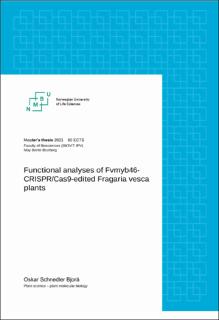| dc.description.abstract | One of the biggest humanitarian challenges in the world today is food security. Improving food production requires improvement in the productivity of existing crops. Plant diseases are major causators of crop yield losses, and generating resistant crops are central to mitigating yields and economical losses by farmers. The application of targeted and precise CRISPR/Cas9 genome editing technology has been a major breakthrough in biological sciences, and can prove to be an important tool for improvement of crop productivity.
The cultivated strawberry (Fragaria X ananassa) is one of the most important fruit crops in the world, and is susceptible to a wide variety of pathogens. The fungal pathogen Botrytis cinerea, which leads to grey mould on a number of species, causes great economical losses on strawberry production worldwide. The wild strawberry (Fragaria vesca) is a diploid relative of the cultivated strawberry, and can be regarded as a model species for genetical studies of strawberry. In this thesis, I have investigated the phenotypes of CRISPR/Cas9-edited plants of F. vesca with a deletion in the transcription factor-coding gene FvMYB46 which is predicted to be involved in the regulation of secondary cell wall formation and pathogen susceptibility. Detached leaf and flower assays were carried out along with gene expression analyses of several pathogenesis related genes on material infected and non-infected with B. cinerea, to see whether the deletion led to higher resistance to the pathogen. No changes in resistance were observed between myb46 mutants and control plants; however, a few genes related to pathogenesis were less expressed in B. cinerea infected myb46 mutants, suggesting that a deletion in MYB46 changes the gene expression response upon pathogenic infection.
Wild type and myb46 mutant plants were then analysed to see differences in secondary wall lignin deposition of floral stems;. Microscopy evidence suggested that lignin deposition in secondary cell walls is downregulated in myb46 mutants compared to controls, indicating that MYB46 plays a role in secondary cell wall deposition. Finally, detached leaves were exposed to different levels of osmotic stress to investigate drought tolerance These results indicated that leaves of myb46 mutants may be more susceptible to drought stress than wild type plants.
From the experiments conducted in this study, it seems that MYB46 is not involved in resistance to grey mould in Fragaria. However, the data in this study suggest that MYB46 may be involved in regulation of drought stress responses and cell wall composition. | en_US |

